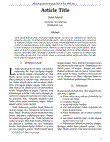Resultados de búsqueda - "El Radical"
Materias dentro de su búsqueda.
Materias dentro de su búsqueda.
- antioxidantes 4
- Antioxidantes 2
- Antioxidants 2
- DPPH 2
- antioxidants 2
- educación 2
- % inhibición 1
- % inhibition 1
- ABTS 1
- Aislado proteico 1
- Alimentos funcionales 1
- Ate 1
- Bolsonaro 1
- Box-Behnken 1
- Brasil 1
- Brazil 1
- COVID-19 1
- Capacidad nutraceútica 1
- Carob 1
- Catholic Church 1
- Citotoxicidad 1
- Comportamiento Emocional 1
- Compuestos fenólicos 1
- Covid-19 1
- Cymbopogon citratus 1
- Cytotoxicity 1
- Decatropis bicolor 1
- Desarrollo urbano 1
- Drying 1
- ESG 1
-
101
Evaluación del efecto neuroprotector de extractos de Datura inoxia y Turnera diffusa en un modelo in vitro de neurotoxicidad.
Publicado 2018“…Dichos efectos se determinaron mediante la evaluación citotóxica en línea celular VERO, la evaluación de actividad neurotóxica en línea celular PC-12, la determinación de efecto neuroprotector en un modelo de neurotoxicidad inducido por glutamato, el establecimiento de actividad antioxidante por ensayo de captación de radical DPPH y la actividad antiapoptótica por ensayo de inhibición de caspasa-3.Contribuciones y Conclusiones: Los extractos D1, D2, D3 y T1 no son citotóxicos en línea celular VERO en todas las concentraciones evaluadas mientras que el extracto T2 no es citotóxico en el rango de 3.125 μg/mL a 50 μg/mL. …”
Enlace del recurso
Tesis -
102
Evaluación del efecto neuroprotector de extractos de Datura inoxia y Turnera diffusa en un modelo in vitro de neurotoxicidad.
Publicado 2018“…Dichos efectos se determinaron mediante la evaluación citotóxica en línea celular VERO, la evaluación de actividad neurotóxica en línea celular PC-12, la determinación de efecto neuroprotector en un modelo de neurotoxicidad inducido por glutamato, el establecimiento de actividad antioxidante por ensayo de captación de radical DPPH y la actividad antiapoptótica por ensayo de inhibición de caspasa-3. …”
Enlace del recurso
Tesis -
103
En defensa de la información y comunicación científica en Open Access gratuito en todos los procesos de publicación y lectura
Publicado 2014“…Finally it makes a political call for all the critical, radical, and progressive anti-capitalist, and leftist scientists, authors, scholars, librarians, and citizens in strategic union and alliances with all the manual and cognitive workers, activists, theorizers, along with all of its working, exploited, oppressed, and dominated classes and their unions, parties and political organizations from all over the world, to politically counter attack, by all the possible means, through all the battle fronts, and permanently, the constant attack of such capitalist bourgeois owners of the world whose renovated fascist ideologies, of the fundamentalist, neoliberal, and neoconservative of the market, have the planet to the brink of the neo-nazi neo-slavery and neo-servitude of the terrestrial intellect, culture, education, science, life, and happiness through the commodification of everything and their fascist pay-per-access control, included all the information-knowledge that used to be free of charge, communal, and democratic.…”
Enlace del recurso
Artículo -
104
Generación de especies oxidantes por métodos homogéneos y heterogéneos
Publicado 2010“…In this way, free hydroxyl radicals (·OH) and ferrate ion [Fe(VI)], currently are non selective species which can degrade organic compounds to CO2 and water transformation.…”
Enlace del recurso
Artículo -
105
Synthesis and physicochemical characterization of photo crosslinked hydrogels of alginate/gelatin and a-tocopherol nanocapsules for their potential use as biomaterials
Publicado 2019“…Therefore, this project proposes the developments of photo crosslinked hydrogel matrices of alginate and gelatin and nanocapsules of polycaprolactone loeaded with atocopherol that have a potential use for a natural regenerative response of the skin by eliminating excessive free radicals. Based on what previously explained the question was raised: Will hydrogels made with biopolymers and loaded with nanoencapsulated a-tocopherol promotes a faster and more effective cell proliferation response? …”
Enlace del recurso
Tesis -
106
Synthesis and physicochemical characterization of photo crosslinked hydrogels of alginate/gelatin and a-tocopherol nanocapsules for their potential use as biomaterials
Publicado 2019“…Therefore, this project proposes the developments of photo crosslinked hydrogel matrices of alginate and gelatin and nanocapsules of polycaprolactone loeaded with atocopherol that have a potential use for a natural regenerative response of the skin by eliminating excessive free radicals. Based on what previously explained the question was raised: Will hydrogels made with biopolymers and loaded with nanoencapsulated a-tocopherol promotes a faster and more effective cell proliferation response? …”
Enlace del recurso
Tesis -
107
-
108
Evaluación in silico de la interacción de fitoquímicos de la albahaca (Ocimum basilicum L.) con un blanco involucrado en estrés oxidativo
Publicado 2023“…Los radicales libres son moléculas que contienen un electrón desapareado, esta característica los hace sumamente reactivos y capaces de modificar a otras moléculas haciéndolas muy reactivas, a través de una reacción en cadena que causa daño oxidativo, en; células y/o tejidos. …”
Enlace del recurso
Artículo -
109
Carotenoides en ate de vegetales
Publicado 2023“…Algunas asociadas a la acción de radicales libres y especies reactivas de oxígeno. Se ha sugerido el incremento en el consumo de antioxidantes a través de los alimentos. …”
Enlace del recurso
Artículo -
110
Flora y vegetación del municipio Álamo Temapache, Veracruz, México
Publicado 2017“…Conclusions: The area has been radically changed by anthropic activities, only 8% of the original vegetation remains. …”
Enlace del recurso
Artículo -
111
Obtención y evaluación de propiedades antioxidantes de extractos de orégano (Lippia graveolens), eucalipto (Eucalyptus cinerea) y chile jalapeño (Capsicum annuum cv.)
Publicado 2023“…Mientras que para la actividad antioxidante el eucalipto presento el mayor porcentaje de inhibición (80.34 %), frente a la captación de radicales libres de DPPH, reflejando de esta manera su alta actividad antioxidante. …”
Enlace del recurso
Artículo -
112
INCREMENTO DE LA EXPRESIÓN DE TLR4 Y EFECTO ANTIOXIDANTE DEL ÁCIDO ACETILSALICÍLICO EN CONEJOS CON DIETA ALTA EN GRASAS
Publicado 2017“…Objective: The objectives of the present study were to evaluate in a model of dyslipidemia in young rabbits fed three months with a diet high in fat (20% palmitic acid), the production of reactive oxygen species and changes in TLR4, COX2 and IL-1β gene expression, as markers of inflammation and oxidative stress; also to evaluate the effect of acetylsalicylic acid on the production of free radicals and on the expression of these genes. Results: In rabbits fed with excess of fat, significantly increased the levels of triglycerides (p<0.05), TLR4 expression, and reactive oxygen species, although in the latter, not significantly. …”
Enlace del recurso
Artículo -
113
Antioxidantes y respuesta inmune en la recuperación de atletas con consumo de zarzamora.
Publicado 2018“…The presence of antioxidants in the diet decreases the reactions producing free radicals, which positively influences the immune response during the recovery of male long distance athletes.…”
Enlace del recurso
Tesis -
114
Antioxidantes y respuesta inmune en la recuperación de atletas con consumo de zarzamora.
Publicado 2018“…The presence of antioxidants in the diet decreases the reactions producing free radicals, which positively influences the immune response during the recovery of male long distance athletes.…”
Enlace del recurso
Tesis -
115
Efecto de la aplicación de yodo sobre el metabolismo redox y expresión génica en tomate (Solanum lycopersicum L.).
Publicado 2017“…An increase in the antioxidantss ascorbate from 18.17 to 41.69 mg L-1 and glutathione from 5.65 mg L-1 to 10.47 mg L-1 was also observed after application daily of the foliar iodide, suggesting an direct neutralization of the iodine to superoxide radicals. Finally, foliar I - and IO3 - direct to substrate applied biweekly showed an increase six-fold the relative density in the expression of SOD gen without obtain the same response on the activity of the enzyme. …”
Enlace del recurso
Tesis -
116
Valor nutritivo de las hojas de la hojarasca del matorral espinoso tamaulipeco en el estado de Nuevo León
Publicado 2020“…Therefore, its inclusion could contribute to a more sustainable livestock, and also due to the tannin content (1.5%) it serves as an antioxidant both to avoid rancidity of the milk and as a source of antioxidants for the human who consumes it, for the prevention or protection of metabolic or degenerative diseases such as Cancer, Diabetes, Thrombopathies, Alzheimer's, etc., where there is an excessive production of free radicals (Perez TG, 2003; Barros et al., 2011; Leopoldini et al., 2011; Moskovitz et al., 2002).…”
Enlace del recurso
Tesis -
117
Efecto de la aplicación de yodo sobre el metabolismo redox y expresión génica en tomate (Solanum lycopersicum L.).
Publicado 2017“…An increase in the antioxidantss ascorbate from 18.17 to 41.69 mg L-1 and glutathione from 5.65 mg L-1 to 10.47 mg L-1 was also observed after application daily of the foliar iodide, suggesting an direct neutralization of the iodine to superoxide radicals. Finally, foliar I - and IO3 - direct to substrate applied biweekly showed an increase six-fold the relative density in the expression of SOD gen without obtain the same response on the activity of the enzyme. …”
Enlace del recurso
Tesis -
118
Valor nutritivo de las hojas de la hojarasca del matorral espinoso tamaulipeco en el estado de Nuevo León
Publicado 2020“…Therefore, its inclusion could contribute to a more sustainable livestock, and also due to the tannin content (1.5%) it serves as an antioxidant both to avoid rancidity of the milk and as a source of antioxidants for the human who consumes it, for the prevention or protection of metabolic or degenerative diseases such as Cancer, Diabetes, Thrombopathies, Alzheimer's, etc., where there is an excessive production of free radicals (Perez TG, 2003; Barros et al., 2011; Leopoldini et al., 2011; Moskovitz et al., 2002).…”
Enlace del recurso
Tesis


